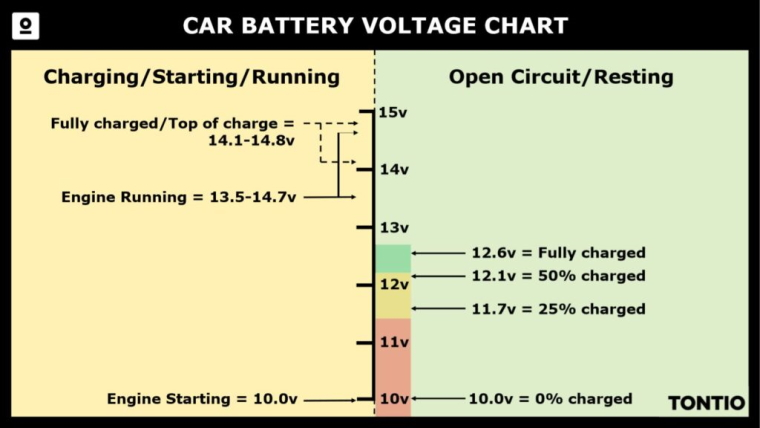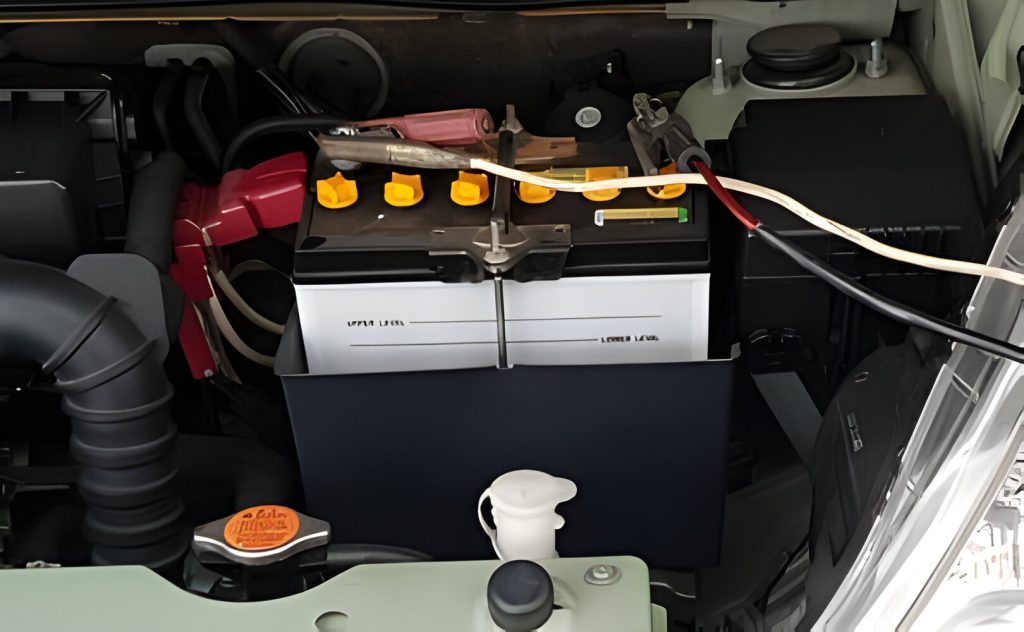A car battery reading of 10 volts is significantly undercharged. To avoid breakdowns, immediate charging or diagnostic checks are necessary.
Car batteries are the unsung heroes of modern vehicles, silently powering all the electrical components from the moment you turn the key. A healthy car battery typically registers around 12. 6 volts when the engine is off and can go up to 13.
7 to 14. 7 volts when the engine is running. A voltage level of 10 volts indicates that the battery lacks charge, possibly due to several reasons, such as a faulty alternator, parasitic drains, or simply an aging battery reaching the end of its life cycle. It’s crucial to address this issue promptly as it can lead to starting problems, weak ignition, and poor performance of the vehicle’s electrical systems. Regular battery maintenance and timely checks can help prevent such scenarios, ensuring your car is always ready for the road.

Credit: www.kwik-fit.com
Car Battery 10 Volts
A car battery typically has a standard voltage of around 12.6 volts when fully charged and in good condition. If a car battery reads 10 volts, it indicates that it is significantly discharged and may be unable to start the vehicle. This low voltage can result from several issues, such as a failing alternator, corroded battery terminals, or simply the battery reaching the end of its lifespan. It’s essential to address a 10-volt reading quickly, as continued strain on a weak battery could lead to complete failure and leave you stranded. Recharge or replace the battery and check the vehicle’s charging system to prevent future problems.
The Significance Of Voltage In Car Batteries
The Significance of Voltage in Car Batteries is crucial for any vehicle owner to understand. Voltage is a vital indicator of a battery’s health and ability to start a car. A fully charged car battery should measure around 12.6 volts when the vehicle is off. When the engine runs, this number should be between 13.7 and 14.7 volts. If a battery reads 10 volts, it’s a red flag.
Why Voltage Matters
Voltage in car batteries is essential for starting the engine. It powers the starter motor, which turns the engine over. Without the correct voltage, the engine won’t start.
- Indicates battery health
- Ensures smooth engine start
- Supports electrical systems
Optimal Voltage For Car Batteries
The optimal voltage of a car battery is crucial to its performance. A healthy car battery typically holds a charge close to 12.6 volts.
| Condition | Voltage |
|---|---|
| Full Charge | 12.6 volts |
| Engine On | 13.7 – 14.7 volts |
| Needs Charge | Below 12.4 volts |
| Dead Battery | Below 11.8 volts |
A reading of 10 volts indicates a severe issue. Seek immediate inspection to avoid breakdowns.
Car Battery 10 Volts
A car battery reading 10 volts typically indicates a problem. Healthy car batteries should measure around 12.6 volts when fully charged and at rest. If a battery reads 10 volts, it suggests that the battery is significantly discharged or failing. This could be due to extended periods of inactivity, extreme temperatures, or an issue with the vehicle’s charging system. Driving with a battery at this voltage can lead to starting problems and potential damage to electrical components.
It’s advisable to test the battery and charging system and consider recharging or replacing the battery to ensure reliable vehicle operation.

Credit: www.walmart.com
Identifying A 10-volt Condition In Your Battery
Car batteries are crucial for starting engines and powering electrical components. A healthy car battery should typically measure around 12.6 volts when the car is off and may go up to around 13.7 to 14.7 volts when the engine is running. A reading of 10 volts, however, signals a problem. Recognizing a 10-volt condition in a car battery is vital for maintaining vehicle reliability and performance.
Symptoms Of Low Voltage
Battery struggles can be the first sign. Your car may take longer to start, or the engine may fail to turn over. Interior lights and headlights might appear dimmer than usual. The infotainment system or other electrical components could malfunction. An early diagnosis is critical to avoiding a dead battery situation.
- Slow engine crank
- Dim headlights and interior lights
- Electrical issues
Testing Your Battery’s Voltage
Measuring voltage is simple. First, ensure the car and all electronics are off. Next, connect a multimeter’s red lead to the positive battery terminal and the black lead to the negative terminal. A 10-volt reading indicates a low charge or potential battery failure.
- Turn off the car and electronics.
- Connect the multimeter’s red lead to the positive terminal
- Connect the black lead to the negative terminal
- Read the multimeter
Note: If the multimeter displays a reading of 10 volts or less, it’s time to seek professional help or consider replacing the battery.
Causes Of A Drop To 10 Volts
Car batteries usually operate around 12.6 volts. A drop to 10 volts indicates an issue. Let’s explore the causes.
Common Reasons For Voltage Decrease
- Corroded Battery Connections: Rust or grime on terminals can impede power flow.
- Interior Lights Left On: Accidentally keeping lights on drains the battery quickly.
- Weak Alternator: The voltage drops if the alternator can’t charge the battery.
- Faulty Battery: Damaged cells within the battery reduce its voltage capacity.
The Impact Of Temperature And Age
Cold Weather: Low temperatures slow down the chemical reaction inside the battery. This can cause a voltage drop.
Heat: High temperatures can evaporate the battery’s liquid, damaging its internal structure.
Battery Age: Over time, batteries lose their ability to hold a charge. An old battery might only show 10 volts.
Effects Of Operating On Low Voltage
Car batteries usually operate at 12 volts. When a battery drops to 10 volts, it can cause serious problems. This section explores the effects of operating on low voltage.
Risks To Vehicle Performance
- Starting issues: A low-voltage battery struggles to turn the engine over.
- Dim lights: Headlights and interior lights may appear dimmer than usual.
- Unreliable operation: Systems like the air conditioner and radio may work poorly.
Potential Damage To Electrical Components
Continued use of a low-voltage battery can lead to permanent damage to various car parts:
| Component | Damage Type |
|---|---|
| Alternator | Overworks and may fail prematurely |
| Electronic control units (ECUs) | Can lose memory or get damaged |
It is crucial to address a low-voltage battery promptly to avoid costly repairs and ensure safe driving conditions.

Charging Strategies For A 10-volt Battery
Maintaining the correct voltage in your car battery is critical for its performance. A 10-volt battery may seem undercharged, but it can reach its optimal power level with proper charging strategies. Let’s explore how to charge a 10-volt car battery efficiently to ensure your vehicle starts every time.
Choosing The Right Charger
Selecting an appropriate charger is the first step to revive a 10-volt battery. Not all chargers fit every battery type. Use these points to choose:
- Check compatibility: Ensure the charger matches your battery specifications.
- Automatic or manual: Automatic chargers adjust the charge rate, while manual chargers require monitoring.
- Charger output: A charger with a 12-volt output is ideal for car batteries.
Step-by-step Charging Process
To charge a 10-volt battery safely, follow these steps:
- Prepare the battery: Clean the terminals and ensure they’re tight.
- Connect the charger: Attach the red clamp to the positive terminal and the black to the negative.
- Set the charger: Choose the lowest rate for a slow charge.
- Monitor the process: Check periodically to avoid overcharging.
- Test the battery: Use a voltmeter to check the charge level.
- Disconnect safely: Turn off the charger before removing the clamps.
By following these steps, your car battery will charge efficiently, ensuring your vehicle is ready to go when you are.
Maintaining Optimal Battery Health
Keeping a car battery at its best means less trouble on the road. A good battery should register about 12.6 volts when the automobile is off. If it drops to 10 volts, it’s a red flag. Proper care extends battery life and ensures reliability. Let’s explore how to keep that vital spark in top condition.
Regular Maintenance Tips
Check the voltage regularly to avoid surprises. Use a multimeter for this simple task.
- Keep terminals clean from corrosion. The solution is baking soda and water.
- Ensure the battery is secure. Vibrations can damage it.
- Inspect the battery case for cracks or bulges. These are signs of trouble.
Top off the battery fluid if it’s a serviceable type. Use only distilled water.
- Unscrew the caps.
- Pour the water carefully.
- Replace the caps securely.
Avoiding Common Battery Draining Practices
| Practice | Why Avoid |
|---|---|
| Leaving lights on | Drains power fast. |
| Short trips | The battery doesn’t fully charge. |
| Using electronics when idle | Extra load on the battery. |
Switch off all lights and unplug devices when the engine is off. This saves power.
Drive longer distances when possible. Short jaunts prevent a complete charge cycle.
Limit device usage when the engine isn’t running. This helps avoid unnecessary strain.
When To Consider Battery Replacement
Knowing when to replace your car battery is crucial for vehicle health. A battery below 12 volts might need checking. Let’s explore signs for battery replacement and how to pick a new one.
Assessing Battery Life
Several signs indicate a dying battery:
- Slow engine crank: The car struggles to start.
- Check engine light: The light appears on the dashboard.
- Low battery fluid level: Visible through the transparent part of the casing.
- Swelling battery case: A bloated case suggests battery failure.
- Battery age: Older than three years? Consider testing.
Use a multimeter to check voltage. A reading under 12.4 volts suggests you should think about a new battery.
Selecting A Suitable Replacement
Choosing the correct battery involves a few steps:
- Check the manual: Your car’s manual lists the correct battery type.
- Consider performance: Higher cold cranking amps (CCA) ensure reliable performance in cold weather.
- Warranty period: Longer warranties offer better long-term value.
- Recycle the old one: Take the old battery to a recycling center.
Picking a battery that matches your car ensures optimal performance. Always opt for quality brands known for reliability and longevity.
| Battery Feature | Importance |
|---|---|
| Voltage | Must match or exceed the car’s original specs. |
| CCA | Colder climates benefit from higher CCA. |
| Warranty | Longer is better. |
| Brand | Choose reputable brands for reliability. |
Credit: www.quora.com
Enhancing Your Ride With The Correct Voltage
Your car’s performance hinges on the correct battery voltage. A robust 12-volt battery typically maintains around 12.6 volts when fully charged. But what if your car battery reads 10 volts? This could signal a problem. Let’s explore how maintaining the correct battery voltage can benefit your ride and why upgrading could be a key to enhanced performance.
Benefits Of Adequate Battery Voltage
- Reliable Engine Starts: The proper voltage ensures your car starts quickly every time.
- Consistent Power Supply: All electronic components get steady power, preventing glitches.
- Longer Battery Life: Correct voltage avoids overworking the battery, extending its life.
- Better Fuel Efficiency: A well-charged battery helps the engine run efficiently.
Upgrading Battery For Performance
A battery with inadequate voltage, like 10 volts, can’t support a car’s demands. Upgrading to a battery that consistently holds a proper charge can transform your ride.
- Choose the Right Type: Match your car with a battery designed for its power needs.
- Check for Compatibility: Ensure the new battery fits perfectly and connects securely.
- Seek Quality Brands: Opt for reputable manufacturers known for long-lasting batteries.
A healthy battery voltage is critical to a smooth, efficient, and reliable driving experience. Keep your car’s voltage in check for the best performance on the road.
Frequently Asked Questions
Is 10 Volts Too Low For A Car Battery?
Yes, 10 volts is too low for a car battery. An automobile battery in good condition should read about 12. 6 volts when fully charged and not in use.
Is 10v A Dead Battery?
A 10V measurement typically indicates a dead or severely discharged car battery. When fully charged, it should normally read around 12. 6 volts.
Will A Car Start On 10 Volts?
A car typically requires at least 12 volts to start reliably. Beginning the car at 10 volts may be challenging or unsuccessful.
What Does It Mean When A Battery Is 10 Volts?
A battery at 10 volts indicates a potential difference of 10 volts between its positive and negative terminals. If its nominal voltage is higher, like 12 volts for a car battery, this typically means the battery is partially discharged.
Conclusion
A 10-volt car battery might seem adequate, but understanding its limitations is crucial. It’s essential to assess whether such a voltage meets your vehicle’s needs. Consider a higher voltage for optimal performance and longevity. Always consult with a professional to choose the best battery for your car.

I am a battery specialist writer and blogger based in the USA & UK . I have been working with battery power energy for 3 long years and I give trips on low battery power problem and solutions . I have a lot of experience with battery power and I share them here.

